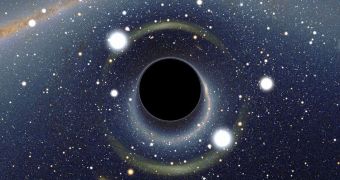A new theoretical investigation has recently determined that black holes can come in a myriad of shapes and sizes. The thing about this theory is that it cannot be proven or disproven, due to the fact that astrophysicists cannot actually investigate the shape of a black hole, or any other of its properties. The structures attract all manner of radiation, including visible light, and so gathering data in the usual manner is impossible. But an expert believes that, when looking at the black holes through the concept of string theory, they become capable of taking on numerous shapes and size.
String theory does not operate with the known four dimensions, but with ten hypothetical ones. In this complex approach, black holes are apparently capable of looking like rings, helices, or even like the planet Saturn, expert Maria Rodriguez says. She is based in Germany, at the Max Planck Institute for Gravitational Physics, in Golm. The expert announces that she has just finished developing a catalog of all known class of black holes, and adds that string theory – which is meant to be a unifying set of calculations that reunites Newtonian physics and quantum mechanics – was very helpful in this regard.
Black holes are formed when massive stars that reach the end of their burning cycles expel the outer layers of their atmosphere in a violent supernova explosion. The remaining core then collapses on itself, due to massive gravitational attractions, and forms a singularity with an incredibly massive center. The gravitational pull that it exerts on surrounding matter is so tremendous that it forms an accretion disk around itself, and then begins to pull on normal matter from its surroundings. Even photons, which are the fastest-traveling particles in the Universe, cannot escape its pull, and fall through the event horizon.
According to Rodriguez, the only possible shape that black holes can take in four dimensions is spherical. But this is not the case when looking at it through string theory. In addition to compiling a list of all forms such a structure can exist in mathematically, the expert also proposes a series of conditions that these shapes must meet in order for them to become likely to exist in the actual Universe. Once verifying for compliance, we are still left with some very interesting objects, including blackfolds, black bowties, bicycling black rings, di-rings, and black helical rings, Technology Review reports.

 14 DAY TRIAL //
14 DAY TRIAL //